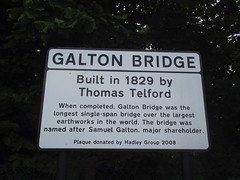Galton Bridge
(1829-present)
Aged 196
Wikidata WikipediaThe Galton Bridge is a cast-iron bridge in Smethwick, near Birmingham, in central England. Opened in 1829 as a road bridge, the structure has been pedestrianised since the 1970s. It was built by Thomas Telford to carry a road across the new main line of the Birmingham Canal, which was built in a deep cutting. The bridge is 70 ft (21 m) above the canal, making it reputedly the highest single-span arch bridge in the world when it was built, 26 ft (7.9 m) wide, and 150 ft (46 m) long. The Galton Bridge is in cast iron, forged at the nearby Horseley Ironworks, with masonry abutments. The design includes decorative lamp-posts and X-shaped bracing in the spandrels. In the 1840s, a railway bridge was built from one of the abutments, with a parapet in keeping with the original. The Galton Bridge carried traffic for over 140 years until it was bypassed by a new road, named Telford Way, in the 1970s, and now only carries pedestrians and cyclists. The scheme involved burying the canal in a tunnel, which was named Galton Tunnel. The bridge is one of six built by Telford that share common design features and the only one still standing without modification. It underwent minor repair work in the 1980s, after which it was repainted from its original black into a colour scheme intended to enhance its features. It is maintained by the Canal and River Trust and lends its name to the nearby Smethwick Galton Bridge railway station. It is a grade I listed building.
DbPedia
Commemorated on 1 plaque
Galton Bridge Built in 1829 by Thomas Telford. When completed, Galton Bridge was the longest single-span bridge over the largest earthworks in the world. The bridge was named after Samuel Galton, major shareholder.
Galton Bridge, Roebuck Lane, Smethwick, United Kingdom where it built (1829)
